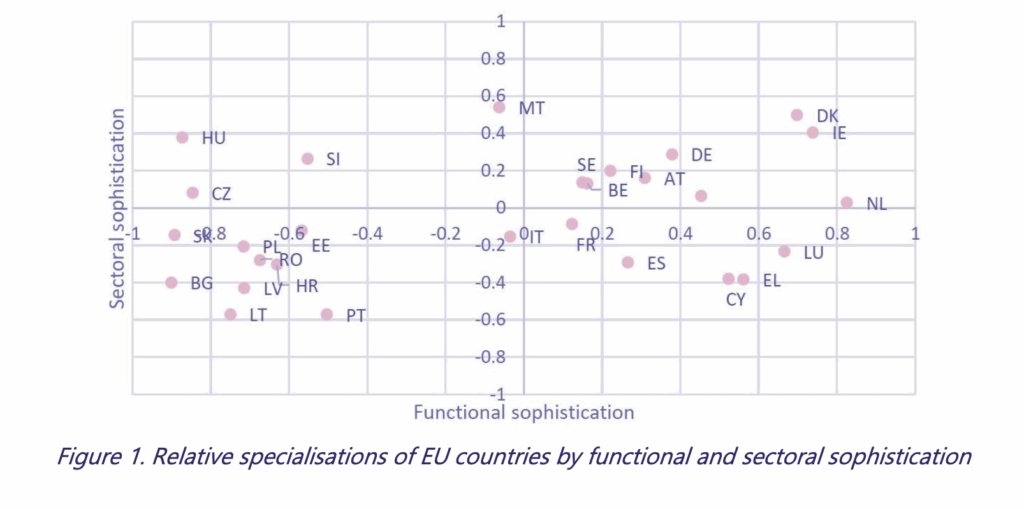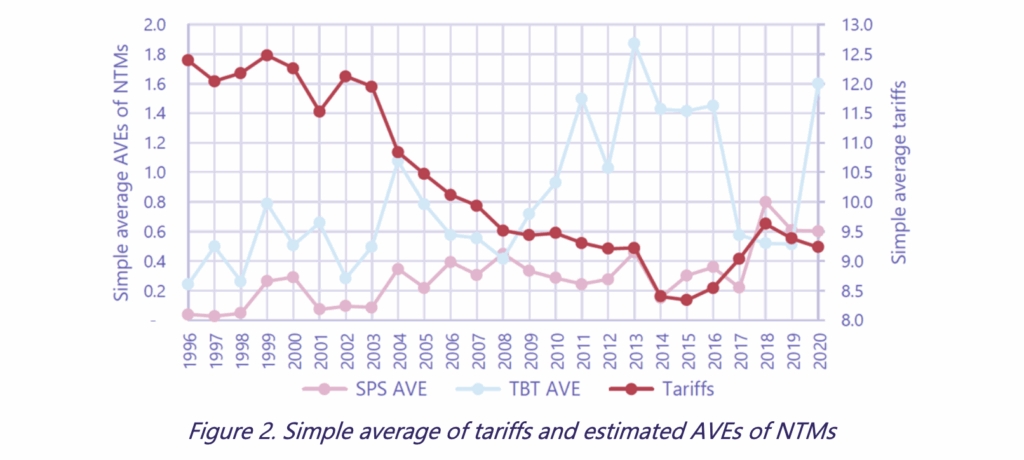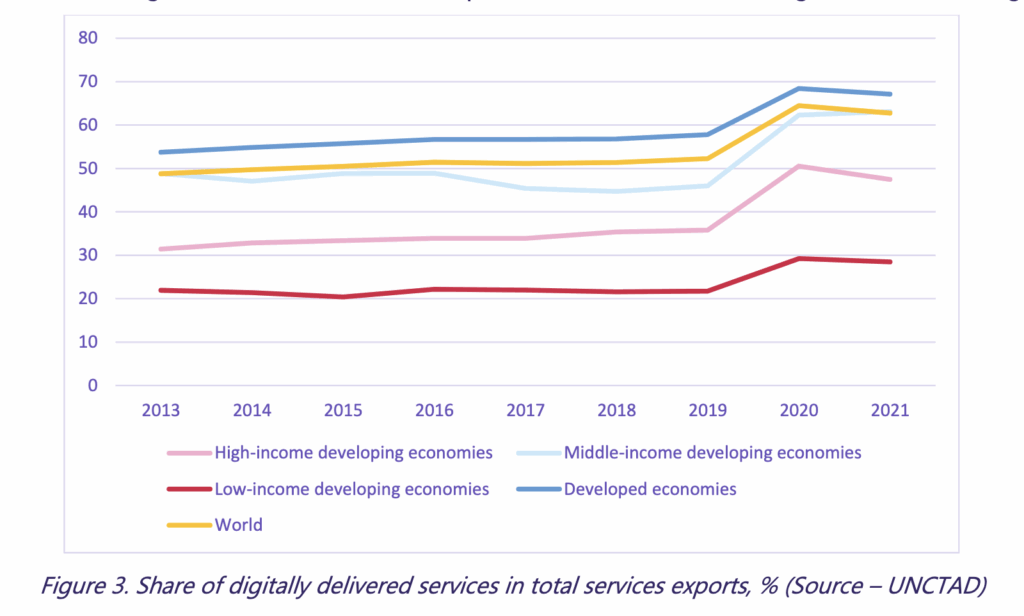INTRODUCTION
The increasing globalization of the world economy has long been subject of debate. Since the global financial crisis in particular, there have been increasing concerns about the social and environmental impacts of Global Value Chains (GVCs) and questions have been raised about the wisdom of strong reliance on these complex interlinked production systems. These concerns fueled a backlash against globalization even before the Covid-19 crisis hit (Rodrick, 2018). In the US, it was manifest in a rise in protectionism and a persistent ‘Trade War’ with China, with important impacts on trade and inevitable spillovers in the EU (Bown and Wang, 2023).
During the pandemic, concerns about the security of supply of key products led to increased policy rhetoric on the risks of relying on GVCs and the need for ‘autonomy’, ‘self-reliance’ and ‘resilience’ including in the US (Lighthizer, 2020) and Europe (Jacobs et al., 2023; Macron, 2023). In spite of extensive debate on whether reconfiguring GVCs would actually deliver greater resilience (Gereffi et al., 2022; Jean & Vicard, 2020; Miroudot, 2020), many governments began to develop new policy interventions aimed at supporting the development of national or regional value chains. At the same time, growing concern about the need to retain technological capacity in key sectors of importance to future growth and the transition to net zero has further encouraged government intervention in ‘strategic’ sectors including electric vehicles, chips and healthcare (Luo & Van Assche, 2023). On both sides of the Atlantic, and globally, policy makers are intervening in GVCs to an extent not seen in decades, as they seek to encourage certain geographic orientations – ‘re-shoring’, ‘near shoring’ or ‘friend-shoring’ – over others.
In this complex and rapidly evolving geo-political and technological context, the EU is seeking to find a balance between retaining its historic openness and securing autonomy in the core sectors vital to its future resilience. This is exemplified in the concept of “open strategic autonomy”, most recently developed in the "Resilient EU2030" proposal drawn by up the Spanish presidency of the Council (Spanish Presidency of the EU, 2023). The initiative underlines the need to address vulnerabilities exposed by the COVID-19 pandemic and rising geopolitical tensions, with a focus on strategic sectors like energy, digital technologies, health, and food. Developing policy to address these concerns requires an in depth understanding of the intricacies of GVCs and their varied effects. The TWINSEEDS project aims to support EU policy makers by providing pertinent and up-to date analysis on the evolution of GVCs and Europe’s position within them, as well as the potential impacts of policy change. This policy brief summarizes the output of the first year of the project, where the focus has been on understanding the long-term evolution of EU-oriented GVCs as well as the impact of the pandemic. It is the fruit of collaboration by analysts in ten different research institutes and universities across the EU.
METHODOLOGIES
The TWINSEEDS project is undertaken by a multi-disciplinary consortium covering economics, business studies, sociology and international political economy. The involved researchers used a variety of methodologies to explore both the evolution of EU-oriented GVCs in recent years and how they reacted to the COVID-19 pandemic. The research combines different methodological approaches rooted in techniques which are both quantitative (e.g. input-output data, econometrics and statistical analysis) and qualitative (e.g. interviews with policy makers and enterprises). Using these varied tools, the research team sought to illuminate different aspects of GVC’s evolution, especially in the light of the ‘Twinseeds’ of technological change and geo-political shifts, while also highlighting the specific impact of the COVID-19 shock and providing a basis for the later work.
MAIN FINDINGS - RECENT TRENDS IN EU GVCs
The research on recent trends in EU GVCs undertaken by the team has been summarized in the first report of the project. The findings highlight the regional division of labor within the EU (Figure 1). Northwestern EU countries have a comparative advantage in functions related to pre- and post- production in high-tech sectors, while Southeastern EU countries specialize in production and lower- tech sectors. Indeed, the industrial integration of EU member states in the 2000s went hand in hand with a functional division of tasks along GVCs, such that the old member states remain strongly specialised in high value-added, R&D activities.
Yet, the EU has lost shares on global R&D output in the last decade and governments increasingly consider dependency on foreign technology as a threat to their sovereignty. Twin Seeds investigated international technology flows in the 2010-19 period. Despite a growing technology dependency on China in all countries, we found no general trend for rising dependencies on foreign technology. Although dependency on China has grown, the EU remains still more dependent on the US and Japan. Overall dependencies remained largely unchanged in the United States and in the EU-27.

The research finds that the promotion of new technologies leads to positive economic outcomes: The uptake of digital technologies like robots and 3D printing can be seen to improve productivity, which in turn improves export performance – although the result is more straightforward for goods than for services.
In terms of trade and investment policy, bilateral policy measures have had important impacts on trade with a limited number of trading partners, mostly those in the EU neighbourhood. Unilateral policy measures such as trade defense tools and preferential access schemes have also had a decisive impact on EU-oriented GVCs. In addition, the team’s research indicates both that non-tariff measures (NTMs) are increasing (Figure 2) and that they pose greater challenges to MNEs’ subsidiaries’ activity and performance than tariffs do, especially in high-tech sectors. However, certain characteristics - like high productivity, foreign ownership and being embedded in international networks - as well as the presence of deep preferential trade agreements, can turn these trade challenges into advantages.

In terms of investment policy, the team also found that Bilateral Investment Treaties (BITs) have been effective in promoting the formation and extension of EU-centered GVCs. Quantitative analysis shows that the existence of BITs affects both the number of EU firms leading production networks and the amount of production facilities they control.
Another notable finding was that involvement in GVCs improves sectoral outcomes – higher levels of sectoral GVC participation is associated with better innovation performance and technology adoption of firms. GVC embeddedness generally goes along with the ability to maintain and develop resources, information, and capabilities.
MAIN FINDINGS - THE IMPACT OF THE PANDEMIC ON GVC ORGANISATION
The team also explored the impact of the pandemic on GVCs in detail. The findings are summarized in the second project report. In terms of the trade policy context during Covid, policy interventions in medical goods were extensive across different countries and they persisted over time. However, Covid-related goods trade still increased substantially during the pandemics. Initial trade data indicates that these regulatory policies may have helped to foster the diversification of the GVC for personal protective equipment (PPE), potentially reducing EU dependence on overseas production, at least of final goods. Policy interventions that affect trade have shifted from more visible ‘regulatory’ trade policy tools like tariffs and bans, to more ‘facilitatory’ tools like industrial policy and subsidies.
However, in the case of France, detailed analysis indicates that few projects were actually directly oriented towards reshoring production.
The coronavirus pandemic put EU companies under the pressure to act quickly despite unprecedented uncertainty levels. Manufacturing companies were hit most strongly and their resilience was determined by the goods produced and the set of operations within the value chain performed. Companies which are more dependent on intermediate inputs are more vulnerable to shocks like Covid. This vulnerability is mitigated in services sectors by higher levels of digitalization; in this respect there was a high level of heterogeneity across services (e.g. travel and transport vs business services). The research found that the impact of COVID-19 on firm-level organizational changes has actually been limited, although it encouraged a reconsideration of business partners. In addition, the findings indicated that the organizations negatively affected by COVID-19 were also those with the capabilities to deal with the challenge. They were more innovative and had the capacity to adopt novel technologies.
In terms of the potential of reshoring in response to the fragilities exposed by the pandemic, the analysis finds limited evidence that this is widespread. Companies who have reshored mainly indicated that they have done so as a result of changes in relative competitiveness. However, restructuring was also found to vary depending on location within the EU and the severity of the pandemic. In Western European regions most affected by Covid, the pandemic seems to have encouraged MNEs in manufacturing and knowledge-intensive sectors to reshore production. On the other hand, Eastern European MNEs in regions badly hit by Covid-19 increased off-shoring, especially in low value-added sectors. This result is mainly driven by small MNEs. For these firms, lockdowns and other stringent measures to deal with the pandemic seem to have encouraged GVC restructuring.

Analysis of the impact of digital capabilities on industrial reshoring indicates that their significance varies depending on the offshoring country. Advanced digital technologies are found to mainly be important in the case of relocations from ‘low-wage’ countries. Analysis of the digitalization of services trade found that it rapidly increased during the pandemic in all regions (Figure 3), but especially in middle income developing countries (which includes India). In the EU, digitalization was found to improve the resilience of exports, a result that was especially strong for some services,( , especially digital services.
Finally, the researchers found that as a result of the pandemic and government responses to it, research capabilities and manufacturing facilities in key medical goods like vaccines and PPE have been expanded and a governance structure has been created to handle health crises. Thus, the EU will be in a better position when the next pandemic hits. However, vulnerabilities persist, especially in relation to the high dependence on China for vaccine ingredients. The strong focus on one technology – mRNA - may also pose risks, as future health crises may require different solutions.
POLICY RECOMMENDATIONS
TRADE AND INVESTMENT POLICIES
Our research confirms that GVC integration has important positive impacts, while trade policy and NTMs have a strong impact on the structure of these value chains. The EU needs to better integrate the complexity of GVCs into decision-making, not only on trade policy, but on all policies with an impact on trade. These include new NTMs, including those seeking to encourage sustainable development (CBAM, regulation on deforestation, etc). The research suggests that GVC integration with key partners can be fostered by including mutual recognition of standards in FTAs. Similarly, it indicates that the negotiation of BITs can support greater GVC integration, especially with countries which have either very similar or very different levels of development. These findings suggests that the reconfiguration of GVCs may require a rethinking of the EU’s neighbourhood policy, especially in view of the changing geopolitical context.
Achieving its wider objectives will also imply that the EU promotes its interests and position on the global stage, in order to secure its economic security, while remaining an international player. Strengthening multilateral institutions is also essential in the face of geopolitical shifts affecting GVCs. The proposed creation of a dedicated role within the European Commission to implement open strategic autonomy could help the EU to play a significant role in shaping geo-economic relations. The EU’s aspiration to balance a sustained liberalization of global trade with reducing reliance on overseas sources of strategic resources may appear contradictory. Embracing this apparent paradox on the international stage will require continuous reassessment in response to shifts in the geopolitical landscape.
INDUSTRIAL POLICY
There are a wide (and increasing) range of EU policies that impact industrialization, yet the EU has not historically had an explicit industrial policy, focusing more on securing supportive framework conditions and an efficient single market. In the current context, the bloc needs to develop a coherent common industrial policy orientation, as all the other big blocs have done. Several elements of the "Resilient EU2030" proposal go in that direction. Within this broad strategy, the green transition can be promoted as a catalyst for resilience, aligning with the evolving landscape of GVCs emphasizing sustainability and innovation. The TWINSEEDS analysis also suggests that encouraging the uptake of digitalization can increase resilience, although its effect varies across sectors. In addition, the research also indicates that reshoring strategies aimed at strategic sectors need to engage with the diversity of EU industrial structures, while restructuring and upgrading strategies need to leverage intra-EU competitive advantages.
Overall, the crisis encouraged restructuring and innovation. Public policy actions can play an important role in supporting this process. Some firms interviewed were influenced by public policy support in their reshoring strategies. Overall, although there is a need to address critical dependencies, there are risks associated with concentrating support on concerns related to pandemic readiness.
R+D AND EDUCATION POLICIES
European R&D and education policies need to support the objectives of industrial policy. The EU must therefore pursue an ambitious level of investment in R+D and education, in order to support leading EU research institutions and companies, while securing the necessary skills in the workforce. Reshoring core sectors will require specific technical skills, which are now often lacking in many regions of the EU. This implies the need for targeted up-skilling and reskilling actions. The findings underline that the availability of appropriate skills is vital to supporting both upgrading/integration into GVCs and the implementation of reshoring strategies. Large-scale training initiatives will be needed to ensure that EU workers acquire or reacquire the capacities needed for the EU to thrive in the post-Covid context.
Digitalization provides a potential lever through which government intervention can influence the export performance of firms. However, not all digitalization technologies have positive impacts on productivity and/or exports, suggesting the need for more fine-grained approach to support structures for R&D and the digital transition. Our research shows that software technologies and business R&D expenditures have particularly strong positive effects at low levels of GDP per capita, highlighting the importance of investments in software and R&D for lower income EU economies. The EU should continue to increase support for R&D in key sectors, such as computers, electronics and pharmaceuticals, where the region currently depends strongly on foreign knowledge.
CONCLUSION
This policy brief reports the initial findings and policy recommendations for the TWINSEEDS project, but much remains to be done. The project team are now assessing the impact of GVC reorganisation on employment and inequalities, the environment and growth and productivity. Based on their findings the team will then develop scenarios for the ‘New Normal’ and provide policy recommendations which build on their findings. This work will be the subject of further reports and policy briefs.
THE TWINSEEDS PROJECT
TWIN SEEDS (Towards a World Integrated and Socio-economically Balanced European Economic Development Scenario) is a research project funded by the Horizon Europe program led by Politecnico di Milano. The objective of the project is to study the recent evolution of Global Value Chains (GVC), focusing on the role played by technological transformations and geopolitical and policy shifts (the ‘Twin Seeds’). It is a joint effort of eleven universities and research institutions from eight EU countries. A key objective of the project is to enrich European debates and inform the development of public policies related to GVC reconfiguration which support economic prosperity, social cohesion and environmental quality.
This policy brief distils the key policy insights which emerge from the first year of research. It builds in particular on the first two work packages which explored recent trends in GVCs and analysed the effects of the COVID-19 on GVCs’ reorganisation. In policy terms, the key issues which the research illuminates relate to how EU policies can shape GVCs (and for which benefits), as well as how EU policies can support the post-pandemic resilience of industry.
Future research will build on this work to explore how GVC reorganisation will affect employment, the environment and economic growth. The team will develop scenarios for the EU ‘New Normal’ in the light of these shifts and propose internal and external EU policies to support the emergence of a scenario which balances the need to ensure robust and sustainable supply chains, with continued openness and engagement with the EU’s key partners in its neighbourhood and beyond.
